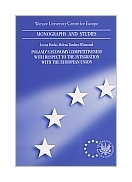|
||
• wydawnictwa polskie
• Zamów informacje o nowościach z wybranego tematu • kontakt
• Cookies na stronie |
POLAND'S ECONOMY COMPETITIVENESS WITH RESPECT TO THE INTEGRATION WITHPAWLAS I. TENDERA-WŁASZCZUK H.wydawnictwo: CEUW , rok wydania 1999, wydanie Icena netto: The work consists of four chapters. The first two chapters create theoretical part of the work. The remaining chapters contain results of empirical research undertaken by the authors. Chapter 1 deals with theoretical background of competitiveness. Main definitions and concepts of competitiveness in both microeconomic perspective and macroeconomic one have been revised. Two separate terms connected with the category 'competitiveness', namely: competitive position and competitive advantage have been distinguished. Such a distinction enables static and dynamic analysis of competitiveness. B. Balassa's and M. Porter's models of national economy's competitive advantage evolution have been analysed. In the final part of this chapter the necessity of studies on competitiveness in a macro scale have been justified. Chapter 2 has been devoted to theoretical analysis of main factors of competitiveness. Main interactions within the triad Science - Technology -Economy have been examined. The system of science, problem of education, importance of technological change as the most important factors of competitive development of national economy have been analysed. Main models of innovation as well as national system of innovation and innovation diffusion have been studied carefully. Chapter 3 begins the empirical part of the present work. It determines Poland's competitive position in the world economy as a whole, and on commodity markets of the EU in particular. First, the description of methodology of research is given. Then presentation of the results of the research follows. Poland's competitiveness has been quantified with the use of a number of ex post quantitative indicators, such as: imports share, exports share, relative market shares, specialisation indicator, exports-imports relations, hypothetical exports, competitiveness indicator, trade coverage indicator, revealed comparative advantage indicator, indices of the intensity of intra-industry trade. The analysis have been supplemented with O.J.Mandeng's portfolio method. In addition to that Revealed Absolute Competitiveness, which is an interesting ex ante measure, has been quantified. Chapter 4 deals with the problem of economic policy as a factor stimulating international competitiveness of national economy. An attempt has been made to present the most interesting programmes undertaken in Poland since 1990. The importance of "Strategy for Poland", "Strategy for Poland: Package 2000", "Guidelines for Innovation Policy in Poland", "Guidelines for Scientific and Technological Policy in Poland" and "Broad-lines of the Long-Term Strategy for Poland's Development up to the Year 2010" has been stressed. The real problem with economic policy in Poland which is not shortage of guidelines, but a low degree of their implementation has been pointed to as well. 119 pages Księgarnia nie działa. Nie odpowiadamy na pytania i nie realizujemy zamówien. Do odwolania !. |


